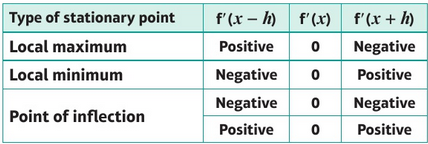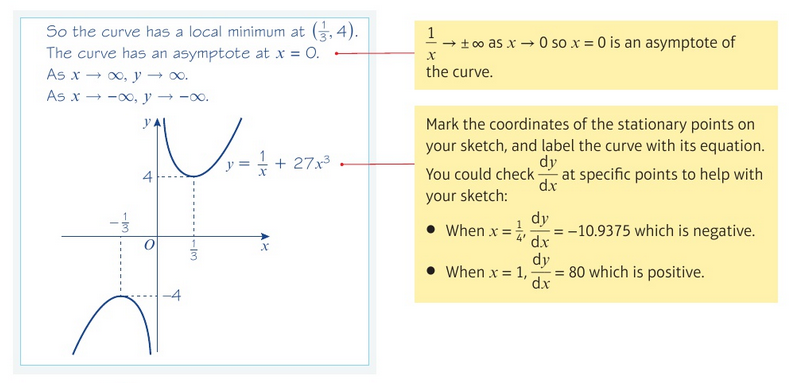Stationary Points
Stationary Points
- A stationary point is a point on a curve where the gradient is 0.
- You can determine weather a stationary point is a local maximum, a local minimum or a point of inflection by looking at the gradient of the curve of either side.
- For any point on the curve \(y=f(x)\) where \(f^{'}(x)=0\) is called a stationary point.


Using the second derivative to find the nature of a stationary point.
- If a function \(f(x)\) has a stationary point when \(x=a\):
- If the second derivative of \(f(a)>0\) then the point is a local minimum.
- If the second derivative of \(f(a)<0\) then the point is a local maximum.
- If the second derivative of \(f(a)=0\) then the point could be a local maximum, or a local minimum or a point of inflection. You have to look at the points on either side to see which it is.
Find the coords of the stationary point on the curve \(y=x^4-32x\)
- \(\frac{dy}{dx}=4x^3-32\)
- Turning point: \(4x^3-32=0\)
- \(4x^3=32\)
- \(x^3=8\)
- \(x=2\)
- Sub back in \(x\): \(2^4-32\times 2=-48\)
- \(\therefore (2,-48)\) is a stationary point.

The curve with equation \(y=x^2-32\sqrt{ x }+20, x>0\) has a stationary point \(P\). Use calculus to find the coordinates of \(P\) and to determine the nature of P.
- First derivative: \(y=2x-16x^{-\frac{1}{2}}\)
- Set = 0: \(2x=\frac{16}{x^{\frac{1}{2}}}\)
- \(2x^{\frac{3}{2}}=16\)
- \(x^{\frac{3}{2}}=8\)
- \(x=4\)
Sub back in for y-coord: \(y=4^2-32\sqrt{ 4 }+20\)
\(=16-64+20\)
\(=-28\)
Coords = \((4, -28)\)
Now find second derivative: \(\frac{d^2y}{dx^2}=2+8x^{-\frac{3}{2}}\)
Sub in: \(=2+8(4)^{-\frac{3}{2}}\)
\(=3\)
\(\frac{d^2y}{dx^{2}}>0 \therefore\) it is a minimum point.
By finding the stationary points, sketch the graph of \(y=\frac{1}{x}+27x^3\)
- First derivative: \(y=\frac{1}{x^2}+81x^2\)
- Set to 0: \(\frac{1}{x^2}+81x^{2} =0\)
- \(81x^2=\frac{1}{x^2}\)
- \(81x^4=1\)
- \(x=\frac{1}{3}\) or \(-\frac{1}{3}\)
- Sub back in for y-coord:\(y=4\) or \(-4\)
- Stationary points are: \(\left( \frac{1}{3}, 4 \right)\) and \(\left( -\frac{1}{3}, -4 \right)\)
